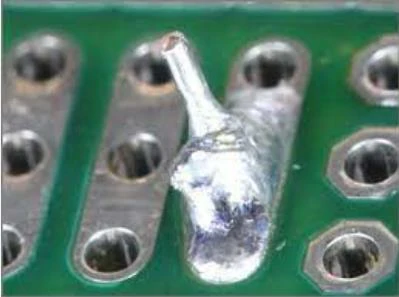
Soldering is a critical process in electronics manufacturing, but it's not immune to defects that can compromise the integrity of solder joints. Understanding common soldering defects, their causes, and effective solutions is essential for achieving high-quality and reliable solder connections. In this article, we will explore some prevalent soldering defects, along with tips to prevent and address them.

Cold solder joints are a frequent issue that results in weak and unreliable connections. To avoid this problem, ensure proper heat transfer by using the appropriate soldering iron temperature and ensuring good contact between the component lead, solder, and PCB pad. Adequate flux application is crucial for promoting good wetting and ensuring a strong bond.

Solder bridges occur when excess solder creates an unintended connection between adjacent conductive areas, causing short circuits. Prevent solder bridges by using the right amount of solder and employing proper technique. Ensure that the solder does not flow beyond the intended joints and clean any excess solder using desoldering tools or solder wick.
Insufficient wetting can lead to weak or incomplete solder joints. To address this problem, clean the surfaces to be soldered to remove contaminants or oxidation. Proper flux application helps improve wetting by reducing surface tension and allowing the solder to spread evenly. Ensure that the soldering iron tip is clean and properly tinned to facilitate good heat transfer and wetting.
Solder splatter can cause short circuits and create a messy work environment. Prevent solder splatter by using the correct soldering iron temperature and technique. Excessive heat or flux can cause solder to splatter, so apply flux sparingly and ensure the soldering iron tip is clean and in good condition.
Solder Balling
Excessive heat or solder can result in solder balling, creating small spherical balls of solder on the PCB or component leads. To avoid this issue, use the right amount of solder for the joint and avoid overheating. Proper flux application, adequate preheating, and soldering techniques such as drag soldering can help achieve smooth, uniform solder joints.

Tombstoning
Tombstoning occurs when a surface-mount component stands vertically on one end during reflow soldering, leading to poor solder joint formation. Prevent tombstoning by ensuring balanced heating during reflow, using equal pad sizes, and ensuring good solder paste adhesion to the pads. Proper stencil design and alignment play a crucial role in reducing tombstoning occurrences.
Lifted Pads or Traces
Excessive heat or mechanical stress during soldering can cause pads or traces to lift or detach from the PCB. Prevent this problem by using the appropriate soldering iron temperature, employing proper technique, and avoiding excessive pressure or movement during soldering. If pads or traces are lifted, repairs may be necessary, which involve careful soldering or PCB rework techniques.
The above is the analysis of common soldering problems on PCB circuit boards. Hope these can help you have some understanding of these defects and try to avoid them in practice.
AiXun is a top provider of smart electronics solutions in China. They specialize in various areas to meet the needs of different industries. One of the products is Precision Soldering.

AiXun specializes in creating precise soldering tools. Soldering is the process of joining electronic components together using melted metal. AiXun intelligent soldering stations are designed to make this process easier and more accurate. These tools are essential for professionals who work with electronics and need precise and reliable soldering. Welcome distributors to inquiry.
 WhatsApp
WhatsApp